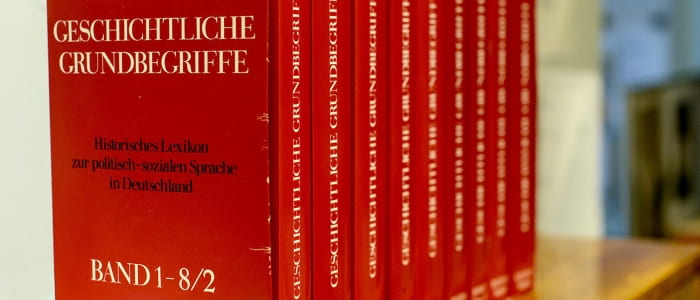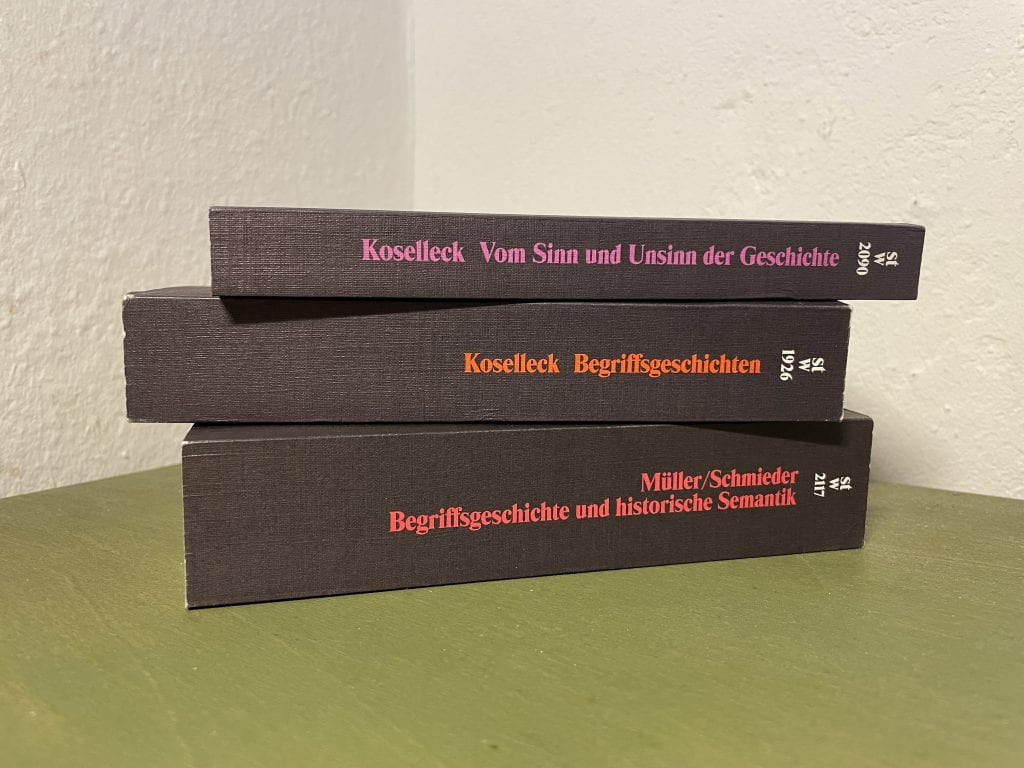by Jonathon Catlin
On April 23, 2023, one of the pioneers of German conceptual history, Reinhart Koselleck (1923–2006), would have turned one hundred years old. Born in Görlitz, in Eastern Germany, Koselleck became one of the leading German historians of his generation and a founder of historical studies at the University of Bielefeld, where he taught for most of his career and trained a generation of conceptual historians who continue to carry on his legacy at universities around the world.
Between 1972 and 1997, Koselleck co-edited, together with Werner Conze and Otto Brunner, the eight-volume Geschichtliche Grundbegriffe: Historisches Lexikon zur politisch-sozialen Sprache in Deutschland (Basic Concepts in History: A Historical Dictionary of Political and Social Language in Germany). The irony is that while Koselleck is perhaps best known for his central role as the theoretical force behind this massive undertaking, by the time it was underway, he already began to cast doubt on some of the premises on which it had been initiated. Amidst the heyday of the linguistic turn and deconstruction’s critique of logocentrism, it became increasingly apparent that traditional Begriffsgeschichte, with its top-down focus on elite political expression, inherently obscured other aspects of social reality. Koselleck soon turned his attention to formerly overlooked stockpiles of historical meaning, including visual and material culture, “political iconology,” and “political sensuality” involving the body and the senses, especially as regards memorials, monuments, and the “political cult of the dead.”
The early Koselleck of his dissertation book Critique and Crisis (1959), a work indebted to his mentor Carl Schmitt (Suhrkamp published their correspondence, edited by Jan Eike Dunkhase, in 2019), studied the high political discourse of the philosophes and Jacobins leading up to the French Revolution. He found in their moralization of history and their utopian and ideological prognostication the roots of the violent totalitarian ideologies of his own time, namely Nazism and Stalinism. In his 1960 review of the book in Merkur, Jürgen Habermas was sharply critical of Koselleck’s proximity to the disgraced Nazi legal theorist Schmitt in privileging of the power of the absolute state over critical social rationality; Habermas’s review also previews the thesis of his 1962 habilitation, The Structural Transformation of the Public Sphere, with its argument that the “private views” Koselleck had criticized as inappropriate moralizing about politics are fundamentally “changed in their substance by being mediated into public opinion through the public sphere” (471). Koselleck, for his part, continued to pander to Schmitt, writing to him in 1961 of the “revolutionary awakening of 1933” which “was gambled away” (191). Both of Koselleck’s co-editors on the Geschichtliche Grundbegriffe were formerly committed Nazis, and their sometimes apologetic politics are visible in places like Ernst Nolte’s entry on “Fascism.”

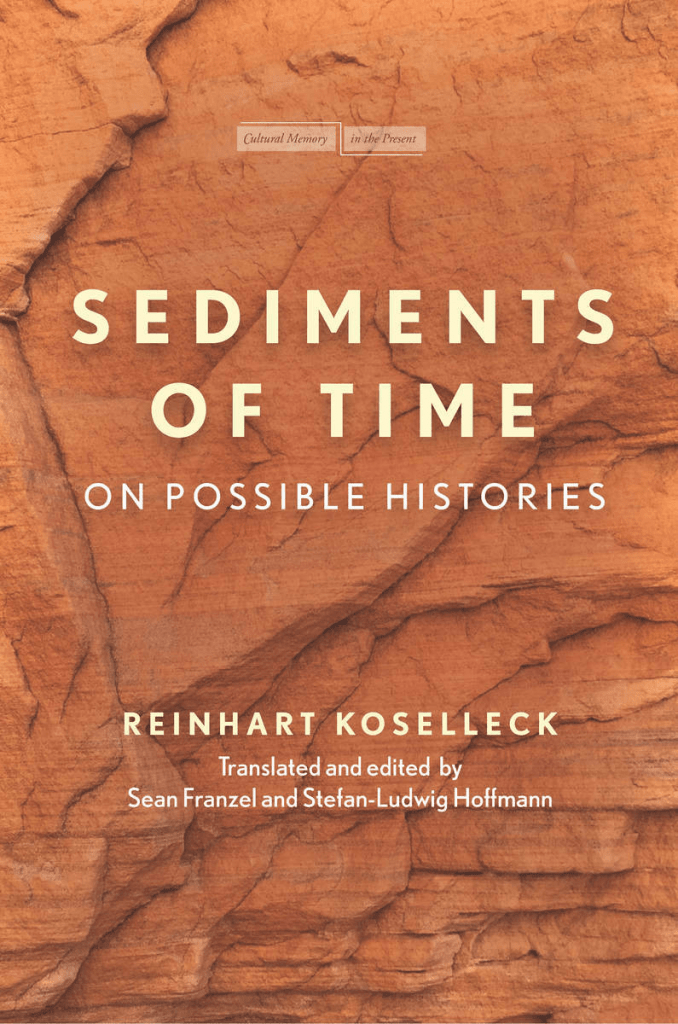
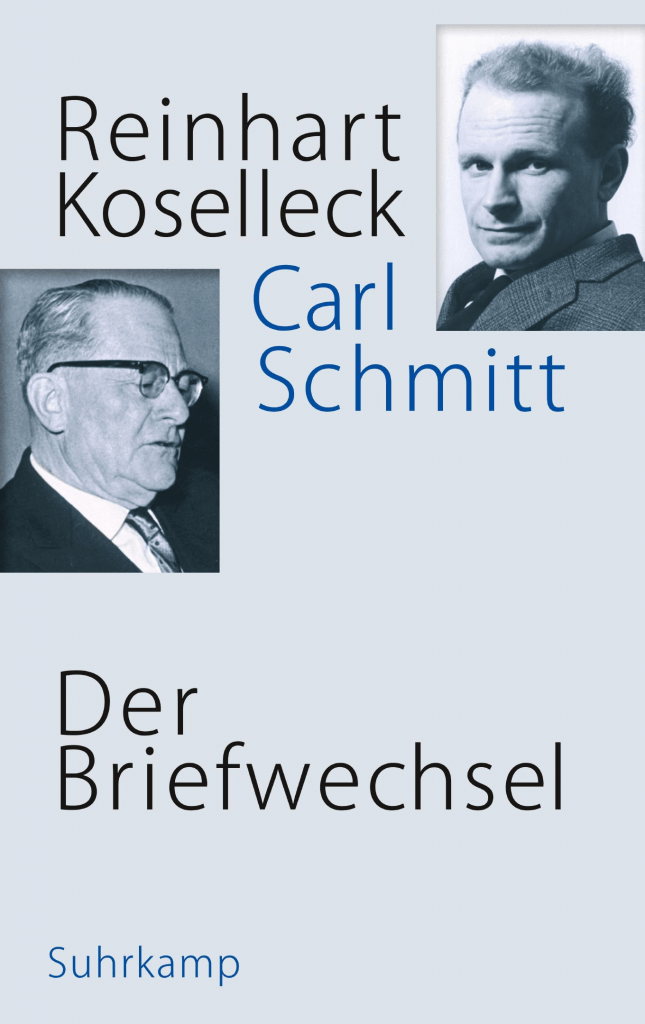
Koselleck’s mature work explored more metaphorical and sensual aspects of historical experience, developing such pioneering concepts and theories as “the non-simultaneity of the simultaneous” and modernity as characterized by acceleration and the widening gap between the “space of experience and the “horizon of expectations,” “futures past,” “repetition structures” and “possible histories,” “layers/sediments of time,” and the absurdity or meaninglessness of history. Koselleck died in 2006, but interest in his work has been renewed in recent years by the unveiling of his 30,000-object (largely digitized) photograph archive at Marburg and the opening of his papers and personal library at the Deutsches Literaturarchiv Marbach.
As Stefan-Ludwig Hoffman shows in his 2017 article, “Koselleck in America,” Koselleck also enjoyed considerable success in the Anglophone world, taking up guest positions at the University of Chicago (where he rubbed elbows with François Furet and Michael Geyer) and the New School for Social Research. Thanks to the efforts of the New York historian of political thought Melvin Richter, Koselleck’s approach to conceptual history was put into dialogue with the approaches of such luminaries as J. G. A. Pocock and Quentin Skinner. As Richter observes, the editors of the Geschichtliche Grundbegriffe’s critiques of the old history of ideas and their turn instead to studying concepts as repositories of embedded social experience resonates with Skinner’s claim that “there can be no histories of concepts; there can only be histories of their uses in argument” (quoted in Richter, 135). While Richter observes that “Pocock and Skinner have seldom ventured beyond the late eighteenth century,” the period of the emergence of modernity and the Sattelzeit with which Koselleck’s work began, in a more theoretical register, “the title of Pocock’s collection, Politics, Language, and Time, could have served as the title for the English translation of Reinhart Koselleck’s Vergangene Zukunft [Futures Past]” (125).
In his later years, Koselleck contributed to German public debates about the memory and memorialization of the Third Reich and the Holocaust. He argued that Germans had a moral duty to remember all victims of the regime, including still forgotten groups such as the more than three million Soviet prisoners of war murdered by the Nazis; he thus opposed the “hierarchy of victims” with Jews at the top established by official national memory and the central memorial in Berlin designed by Peter Eisenman. In this work, he drew upon his own “lava” (untransmissible) memories of his time as a Wehrmacht soldier on the Eastern Front who was captured and sent to Auschwitz and the interior of the Soviet Union as a prisoner of war from 1945–46. In 2005, on the sixtieth anniversary of the end of the Second World War in Europe, Koselleck reflected that he “built up [his] entire studies through the experience of the war.” However, he also emphasized the individuality of his experience, claiming that “each person has the right to their own memory.” In his case, May 8, 1945 was not a day of “liberation” (as Weizsäcker famously proclaimed in 1985) but rather marked the beginning of his “slavery.” Koselleck did not identify as a liberated “victim” of the regime because he fought to the end; “we Germans were also perpetrators in a very clear sense, whether as concentration camp guards or as soldiers.” After the war, his “re-education” officer was none other than the young British historian Eric Hobsbawm, of whom Koselleck also published a caricature in Vorbilder – Bilder (1983).
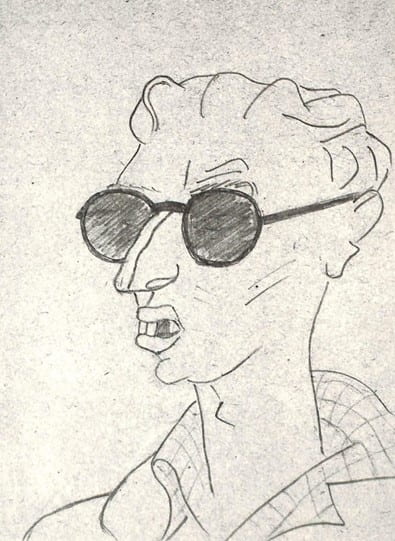
Niklas Olsen’s indispensable 2012 intellectual biography of Koselleck centers on the basic thesis on which all of his work rests: the inescapable plurality and plurivocity of historical experience and, therefore, of historical writing, which makes historical memory and historiography sites of perpetual reinterpretation and conflict. This lends Koselleck’s writing admirable humility, longevity, and contemporary resonance.
Over the years, the JHI Blog has published pieces on Koselleck’s work from a variety of angles, ranging from his early work on the notion of crisis, to his late work on war memorials, to his photographs. We are glad to feature these pieces here on Koselleck’s centennial:
- “Back in the Sattel(zeit) again” by John Raimo, 2015.
- “Koselleck and the Image” (review of the Bielefeld exhibition) by Jonathon Catlin, 2018.
- “Reinhart Koselleck on Modernity, Memorials, and the Meaninglessness of History” by Ella Myer, 2019.
- “Crisisⁿ or, Rebooting Conceptual History for the Twenty-First Century” by Alex Langstaff, 2019.
- “Begriffsgeschichte’s History: Between Historicization of Concepts and Conceptual Politics” interview with Falko Schmieder by Jonas Knatz, 2019.
- “Begriffsgeschichte’s Methodological Neighbors and the Scientification of Concepts” part two of Jonas Knatz’s interview with Falko Schmieder, 2019.
To celebrate the anniversary, a conference is planned at the University of Bielefeld on Koselleck’s birthday, April 23, at which a number of new projects will be presented. These include a forthcoming volume, Vom Ding und Unding der Geschichte (Transcript, 2023), edited by Lisa Regazzoni, on Koselleck’s collection of hundreds of figurines (especially of soldiers and horses). There is also a new anniversary blog entitled Komposita, whose name evokes the composite metaphors and meanings Koselleck employed in his studies of historical semantics. Komposita is hosted by the existing blog Theory of History at Work. On January 24, Komposita began publishing entries, in multiple languages, on new and old concepts related to Koselleck’s work or conceptual history, with the aim to build a new lexicon or glossary of conceptual history from a younger and more international generation of scholars. Komposita continues to invite contributions on concepts not yet covered by the blog, which can be classics of Koselleck’s work (crisis, progress, futures past) or entirely novel and non-European concepts whose study his work can inform (see Margrit Pernau’s reflection on jinns). In the spirit of international exchange and to expand this project to an English-speaking audience, the JHI Blog will cross-publish a small number of Komposita entries in the coming weeks and months.

In October 2023, the Bielefeld event will be followed by the conference “Mit Koselleck über Koselleck hinaus: Perspektiven zu einer Begriffsgeschichte des 20. Jahrhunderts” at Berlin’s Leibniz-Center for Literary and Cultural Studies, home to the ongoing project on an interdisciplinary conceptual history of the twentieth century in Germany. This project’s leaders, Falko Schmieder and Ernst Müller, have together authored two important works on conceptual history. First, the 2016 Begriffsgeschichte und historische Semantik, which historicizes the project of Begriffsgeschichte amongst other related methodologies, from Frankfurt School critical theory, to Foucauldian genealogy, to Hans Blumenberg’s metaphorology, and about which the JHI Blog’s Jonas Knatz conducted a trenchant two-part interview with Schmieder in 2019. Second, in 2020, a new introduction to Begriffsgeschichte. As Schmieder emphasized at the History of Concepts conference in Berlin in the spring of 2022, Begriffsgeschichte for the twentieth century has to look—in a word—a lot more postmodern. Picking up where the Geschichtliche Grundbegriffe left off, and coming after the linguistic and global turn, Schmieder and his collaborators have more distance between themselves and the twentieth century than Koselleck did, but they nevertheless confront an era in which meaning became increasingly fragmented, mediatized, and democratized, and in which the somewhat bounded national linguistic communities of the Geschichtliche Grundbegriffe mixed, transformed, and eroded.
No doubt these new commemorations and reinterpretations of Koselleck’s rich and wide-ranging corpus will continue to reinvigorate conceptual history for a younger, more international cohort of scholars no longer beholden to the original aims and methods of Koselleck and his generation. To give just one recent example, Jennifer L. Allen’s history of “utopia” in Germany since the 1980s looks not to high political rhetoric, where this lofty and totalizing concept was indeed predictably faltering amidst the collapse of real existing socialism, but rather to thriving “sustainable” and grassroots notions of utopia that were embedded in everyday social practices and activism. (Koselleck, for his part, claimed that his “basic attitude was skepticism as the minimum condition for reducing utopian excess—including the utopian excess of 1968.”) In our time of unrelenting pandemic, ongoing climate catastrophe, and the end of the end of history following the Russian invasion of Ukraine, terms like “permacrisis” and “polycrisis” have entered critical and political discourse in force. At such moments, Koselleck’s canonical attempts to historicize such fundamental modern concepts as “crisis” and “progress,” “revolution” and “history” may seem particularly timely. In contemporary deployments of modern “semantic stockpiles” such as these, we see, in Anson Rabinbach’s words, that “not only are concepts capable of synthesis, they’re also capable of explosion and they create shockwaves that keep reproducing themselves” (470). But, following Schmieder and Müller’s suggestion, we must also historicize Koselleck himself, thinking with him in order to ultimately think beyond him.
Jonathon Catlin is a Fellow in the Berlin Program at Freie Universität Berlin and a PhD Candidate in History and the Interdisciplinary Doctoral Program in the Humanities at Princeton University, where he is writing a dissertation on the concept of catastrophe in twentieth-century European thought. He has contributed to the JHI Blog since 2016 and served as a contributing editor since 2018. He is also an editor of Komposita, the Koselleck anniversary blog based at the University of Bielefeld. He tweets @planetdenken.
Edited by Tom Furse
Featured Image: Cover and complete collection of the Geschichtliche Grundbegriffe, by Otto Brunner, Werner Conze and Reinhart Koselleck (eds.). Picture by Mika Federley, published on the website of the University of Helsinki, 2017. Wikimedia.
